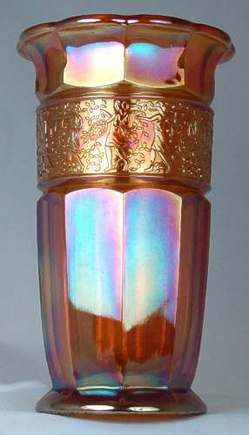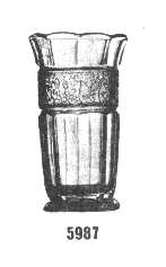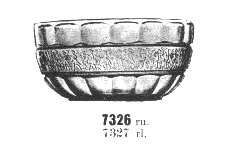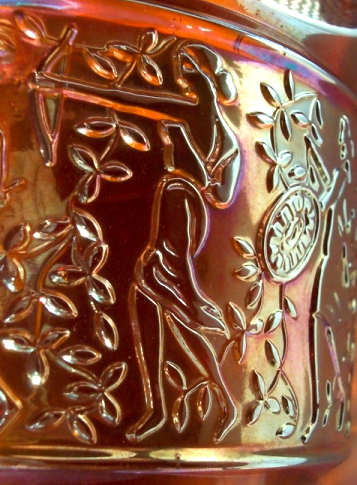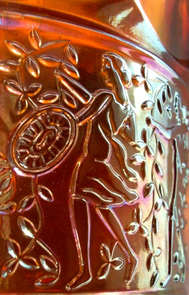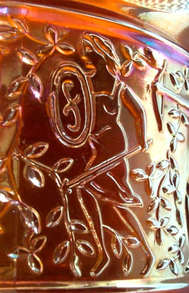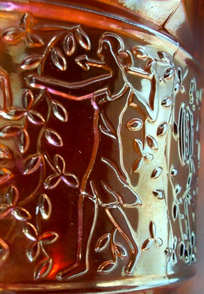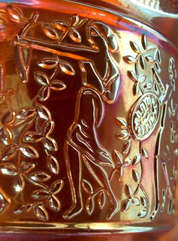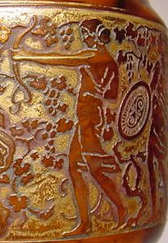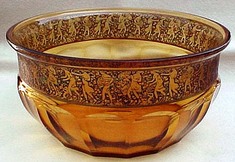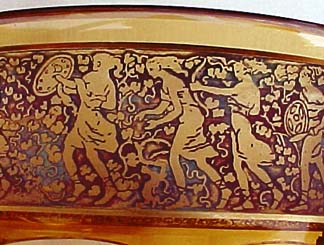Riihimaki's Amazon Women!
|
It's often said that there is nothing new in life, no new thing under the sun.
Carnival Glass is no exception. The number of different patterns is well over a thousand, probably over two thousand, maybe even approaching three thousand, with recent advances in research and discoveries being made in Scandinavia, Europe, South America and India. Many patterns and shapes were inspired or influenced by the styles and trends of the time; but other forms of glass, other patterns, and undoubtedly, other manufacturer's ideas, all played their part. This is one of the aspects of Carnival that we look at in our new book "The Art of Carnival Glass" - and in one intriguing section we take a look at some specific examples of design links and influences, as well as outright plagiarism, on the development of Carnival Glass patterns. Northwood's Tornado vase, Imperial's Open Rose and Nu-Art Homestead designs, Millersburg's Seacoast pintray, Dugan's Nautilus - you'll be able to find out where the inspiration for these designs and others may well have originated. One amazing example of inspired design is this superb "Amazon Women" vase (currently the only example known) made by Riihimaki of Finland. The vase was shown in Riihimaki's 1939 catalogue as below, but it could well have been made in the decade leading up to that date.
|
There are four different female figures repeated around the splendid vase, as shown above.
So, what was the inspiration behind this vase?
The answer is undoubtedly provided by a study of Bohemian glass from around 1920-1925 - as the inspiration for this example of Riihimaki's Carnival was surely Moser's "Fipop" Amazon pattern range which featured their trademarked "Oroplastique" decor. This technique was developed by Leo Moser and was an acid etched band colored in olive green and dark red-brown, with a gold band above and below. Moser's items were made at their Karlovy Vary glassworks in Czechoslovakia. Bowls, vases and other items were made by Moser featuring an acid-etched band of Amazon warriors.
The answer is undoubtedly provided by a study of Bohemian glass from around 1920-1925 - as the inspiration for this example of Riihimaki's Carnival was surely Moser's "Fipop" Amazon pattern range which featured their trademarked "Oroplastique" decor. This technique was developed by Leo Moser and was an acid etched band colored in olive green and dark red-brown, with a gold band above and below. Moser's items were made at their Karlovy Vary glassworks in Czechoslovakia. Bowls, vases and other items were made by Moser featuring an acid-etched band of Amazon warriors.
In the photos above, there is a detail of the female archer figure on the band of the Riihimaki Carnival example, and alongside it is a detail from a Moser piece (not Carnival). The inspiration is clear. Also shown is a splendid Moser bowl in the "Fipop" (Amazon) pattern and a detail of the "Oroplastique" decor. This item (and the information on Moser's glass in this article) is reproduced here courtesy of Sindelar & O'Brien Antiques & Design, Inc.
